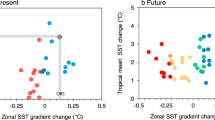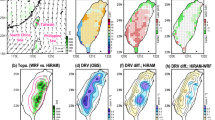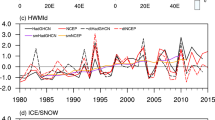Abstract
Over the past 60 years, both average daily precipitation intensity and extreme precipitation have increased in many regions1,2,3. Part of these changes, or even individual events4,5, have been attributed to anthropogenic warming6,7. Over the Black Sea and Mediterranean region, the potential for extreme summertime convective precipitation has grown8 alongside substantial sea surface temperature increase. A particularly devastating convective event experienced in that region was the July 2012 precipitation extreme near the Black Sea town of Krymsk9. Here we study the effect of sea surface temperature (SST) increase on convective extremes within the region, taking the Krymsk event as a showcase example. We carry out ensemble sensitivity simulations with a convection-permitting atmospheric model and show the crucial role of SST increase in the extremeness of the event. The enhancement of lower tropospheric instability due to the current warmer Black Sea allows deep convection to be triggered, increasing simulated precipitation by more than 300% relative to simulations with SSTs characteristic of the early 1980s. A highly nonlinear precipitation response to incremental SST increase suggests that the Black Sea has exceeded a regional threshold for the intensification of convective extremes. The physical mechanism we identify indicates that Black Sea and Mediterranean coastal regions may face abrupt amplifications of convective precipitation under continued SST increase, and illustrates the limitations of thermodynamical bounds for estimating the temperature scaling of convective extremes.
This is a preview of subscription content, access via your institution
Access options
Subscribe to this journal
Receive 12 print issues and online access
$259.00 per year
only $21.58 per issue
Buy this article
- Purchase on Springer Link
- Instant access to full article PDF
Prices may be subject to local taxes which are calculated during checkout




Similar content being viewed by others
References
Groisman, P. Y. et al. Trends in intense precipitation in the climate record. J. Clim. 18, 1326–1350 (2005).
Donat, M. G. et al. Updated analyses of temperature and precipitation extreme indices since the beginning of the twentieth century: The HadEX2 dataset. J. Geophys. Res. 118, 2098–2118 (2013).
Seneviratne, S. I. et al. in Managing the Risks of Extreme Events and Disasters to Advance Climate Change Adaptation (eds Field, C. B. et al.) 109–230 (IPCC, Cambridge Univ. Press, 2012).
Pall, P. et al. Anthropogenic greenhouse gas contribution to flood risk in England and Wales in autumn 2000. Nature 470, 382–385 (2011).
Herring, S. C., Hoerling, M. P., Peterson, T. C. & Stott, P. A. (eds) Explaining extreme events of 2013 from a climate perspective. Bull. Am. Meteorol. Soc. 95, S1–S96 (2014).
Zhang, X. et al. Detection of human influence on twentieth-century precipitation trends. Nature 448, 461–465 (2007).
Min, S.-K., Zhang, X., Zwiers, F. W. & Hegerl, G. C. Human contribution to more intense precipitation extremes. Nature 470, 378–381 (2011).
Dee, D. P. et al. The ERA-Interim reanalysis: Configuration and performance of the data assimilation system. Q. J. R. Meteorol. Soc. 137, 553–597 (2011).
Kotlyakov, V. M. et al. Flooding of July 6–7, 2012, in the town of Krymsk. Reg. Res. Russia 3, 32–39 (2013).
Lenderink, G. & van Meijgaard, E. Increase in hourly precipitation extremes beyond expectations from temperature changes. Nature Geosci. 1, 511–514 (2008).
Berg, P., Moseley, C. & Haerter, J. O. Strong increase in convective precipitation in response to higher temperatures. Nature Geosci. 6, 181–185 (2013).
Emori, S. & Brown, S. J. Dynamic and thermodynamic changes in mean and extreme precipitation under changed climate. Geophys. Res. Lett. 32, L17706 (2005).
Trenberth, K. E. Conceptual framework for changes of extremes of the hydrological cycle with climate change. Climatic Change 42, 327–339 (1999).
Semenov, V. A. & Bengtsson, L. Secular trends in daily precipitation characteristics: Greenhouse gas simulation with a coupled AOGCM. Clim. Dynam. 19, 123–140 (2002).
Orlowsky, B. & Seneviratne, S. I. Global changes in extreme events: Regional and seasonal dimension. Climatic Change 110, 669–696 (2012).
Cortesi, N., Gonzalez-Hidalgo, J. C., Brunetti, M. & Martin-Vide, J. Daily precipitation concentration across Europe 1971–2010. Nature Hazards Earth Syst. Sci. 12, 2799–2810 (2012).
Kendon, E. et al. Heavier summer downpours with climate change revealed by weather forecast resolution model. Nature Clim. Change 4, 570–576 (2014).
Reynolds, R. W. et al. Daily High resolution Blended Analyses for sea surface temperature. J. Clim. 20, 5473–5496 (2007).
Oguz, T., Dippner, J. W. & Kaymaz, Z. Climatic regulation of the Black Sea hydro-meteorological and ecological properties at interannual-to-decadal time scales. J. Mar. Syst. 60, 235–254 (2006).
Neu, U. et al. IMILAST: A community effort to intercompare extratropical cyclone detection and tracking algorithms. Bull. Am. Meteorol. Soc. 94, 529–547 (2013).
Tilinina, N., Gulev, S. K., Rudeva, I. & Koltermann, P. Comparing cyclone life cycle characteristics and their interannual variability in different reanalyses. J. Clim. 26, 6419–6438 (2013).
Skamarock, W. C. et al. A Description of the Advanced Research WRF Version 3 Tech. Note NCAR/TN-475+STR (Mesoscale and Microscale Meteorology Division, National Center for Atmospheric Research, 2008)
Weisman, M. L., Davis, C., Wang, W., Manning, K. W. & Klemp, J. B. Experiences with 0–36-h Explicit Convective Forecasts with the WRF-ARW Model. Weath. Forecast. 23, 407–437 (2008).
Hardwick Jones, R., Westra, S. & Sharma, A. Observed relationships between extreme sub-daily precipitation, surface temperature, and relative humidity. Geophys. Res. Lett. 37, L22805 (2010).
Stott, P. A., Stone, D. A. & Allen, M. R. Human contribution to the European heatwave of 2003. Nature 432, 610–614 (2004).
Fischer, E. M., Seneviratne, S. I., Vidale, P. L., Lüthi, D. & Schär, C. Soil moisture-atmosphere interactions during the 2003 European summer heat wave. J. Clim. 20, 5081–5099 (2007).
Kirtman, B. et al. in Climate Change 2013: The Physical Science Basis (eds Stocker, T. F. et al.) Ch. 11 (IPCC, Cambridge Univ. Press, 2013).
Loeptien, U., Zolina, O., Gulev, S., Latif, M. & Soloviov, V. Cyclone life cycle characteristics over the Northern Hemisphere in coupled GCMs. Clim. Dynam. 31, 507–532 (2008).
NCEP FNL Operational Model Global Tropospheric Analyses, continuing from July 1999 National Centers for Environmental Prediction/National Weather Service/NOAA/US Department of Commerce (accessed 20 November 2013); http://dx.doi.org/10.5065/D6M043C6
Miguez-Macho, G., Stenchikov, G. L. & Robock, A. Spectral nudging to eliminate the effects of domain position and geometry in regional climate model simulations. J. Geophys. Res. 109, D13104 (2004).
Acknowledgements
The authors thank M. Akperov for assistance with analysis, A. Gavrikov for helpful comments about the simulation, and O. Bulygina for providing meteorological data from the All-Russian Research Institute of Hydrometeorological Information—World Data Centre. Simulations were carried out at the North-German Supercomputing Alliance (HLRN). This study was financially supported by the EUREX project of the Helmholtz Association (HRJRG-308) and partially supported by the Russian Ministry of Education and Science (contracts 14.B25.31.0026), the RF President grant (MK-3895.2014.5) and the Russian Foundation for Basic Research (grants 12-05-91323, 14-05-00518, 15-35-20962). Russian meteorological data were processed and supported by the Russian Science Foundation (grant 14-17-00700).
Author information
Authors and Affiliations
Contributions
V.A.S. had the initial idea for the experiment. E.P.M., V.A.S. and D.M. jointly designed the experiment and wrote the manuscript. E.P.M. performed the simulations. E.P.M. performed the analysis, with support from V.A.S. and additional contribution from D.M., W.P. and A.V.C. All authors discussed the results and commented on the manuscript.
Corresponding author
Ethics declarations
Competing interests
The authors declare no competing financial interests.
Supplementary information
Supplementary Information
Supplementary Information (PDF 14000 kb)
Supplementary Information
Supplementary Information (GIF 2396 kb)
Supplementary Information
Supplementary Information (AVI 16276 kb)
Rights and permissions
About this article
Cite this article
Meredith, E., Semenov, V., Maraun, D. et al. Crucial role of Black Sea warming in amplifying the 2012 Krymsk precipitation extreme. Nature Geosci 8, 615–619 (2015). https://doi.org/10.1038/ngeo2483
Received:
Accepted:
Published:
Issue Date:
DOI: https://doi.org/10.1038/ngeo2483
This article is cited by
-
Advancing research on compound weather and climate events via large ensemble model simulations
Nature Communications (2023)
-
An Updated Review of Event Attribution Approaches
Journal of Meteorological Research (2022)
-
Heat and freshwater changes in the Indian Ocean region
Nature Reviews Earth & Environment (2021)
-
Variations in extreme wave events near a South Pacific Island under global warming: case study of Tropical Cyclone Tomas
Progress in Earth and Planetary Science (2020)
-
A first-of-its-kind multi-model convection permitting ensemble for investigating convective phenomena over Europe and the Mediterranean
Climate Dynamics (2020)



